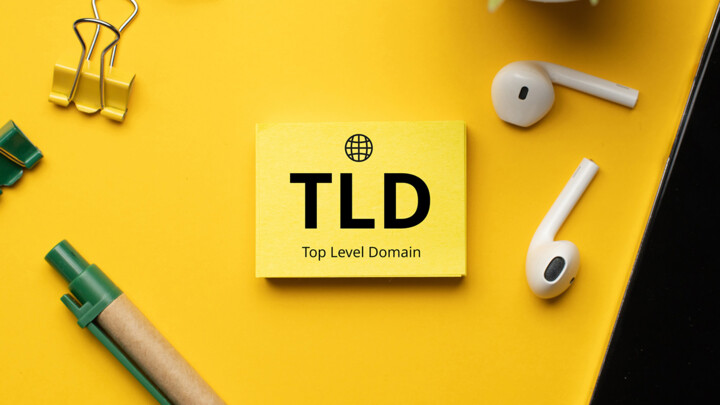From Domain Names to Trademark Protection: Safeguard Your Brand’s Digital Identity
Simone Catania, InterNetX, outlines how to choose the perfect domain name, common issues to consider and exactly how to protect your digital identity.

©gesrey | istockphoto.com
With consumers relying on the Internet for shopping, research and communication, establishing a strong digital identity is paramount for businesses of all sizes. In today’s digital landscape, building a sturdy online presence means starting with the right domain name.
Recently, some innovative native digital brands have even taken this strategy one step further, incorporating the top-level domain (TLD) into their brand name. These forward-thinking companies distinguish themselves from the competition by seamlessly integrating the TLD into their brand name; thereby increasing brand recognition and visibility across all touch points. This attention to detail showcases their commitment to digital excellence and reinforces their brand identity in the minds of their target audience. In this article, we will demonstrate the importance of domain names as a critical element of your brand’s digital identity, and you will learn about the factors contributing to selecting the perfect domain name for your brand. We will discuss how it impacts your online presence and marketing strategies, as well as how to protect it from infringements. And finally, we will also give you some advice on securing your domain name in the namespace.
The domain name as the key to a brand’s digital success
A domain name is a unique and human-readable web address that allows users to enter a website. It acts as a digital identifier for your website, ensuring visitors can effortlessly find their way to your online presence. It can contain letters, numbers and hyphens but cannot begin or end with a hyphen.
The domain name typically consists of two main parts: the domain itself (e.g., example) and the top-level domain (e.g., .com, .org, .net). There are over 1,500 TLDs. These include well-known gTLDs like .com, country-specific TLDs like .de for Germany or .us for the United States, geoTLDs like .berlin or .africa and category and purpose-driven TLDs like .fun, .auto or generic TLDs without any clear implication, such as .xyz. Choosing an effective TLD that accurately represents the brand, its scope or location and aligns with its goals and mission can significantly impact a brand’s digital identity. A well-selected TLD can enhance a brand’s relevance and visibility, enabling businesses to connect with their target audience more effectively.
Elevating your digital identity with the perfect domain name
A domain name is an investment in your online reputation and brand recognition. It gives your brand a distinctive digital identity, positioning you as a trustworthy and established player in your industry. Not only does it provide customers with easy access to your website and enable interactions with your products or services, but it also serves as a digital representation of your brand’s values, personality and offerings. As such, the domain name becomes a central component of your marketing mix.
To ensure your brand’s digital identity is elevated to its full potential, here are some key elements to consider when choosing your domain name.
#1 First impression
The domain name serves as the virtual storefront, playing a crucial role in shaping the customer’s initial impression and setting the tone for their digital experience. Ensuring that your domain name aligns seamlessly with your brand helps create a positive first impression and fosters instant recognition among your desired audience.
#2 Relevance
When picking a domain name, there is no one-size-fits-all solution. Ideally, your domain name should either fully match your brand name, be closely related to your business or industry or contain meaningful keywords. A relevant domain name is a powerful visibility instrument that attracts the right audience and delivers the right message about the content they will find.
#3 Credibility and industry authority
In the crowded digital landscape, consumers rely on trust signals to determine the authenticity and reliability of a brand. A professional and reputable domain name conveys trust, professionalism and relevance and thus can position the brand as an industry authority. This gives customers confidence in the brand, making them more likely to engage with its offerings. Yet, an ill-fitting or poorly selected domain name can have the opposite effect by confusing or disengaging customers.
#4 Brand recognition & awareness
A domain name can significantly impact a brand’s visibility and recall, providing a unique and memorable identity for your business online. When it matches your brand or business name, it helps customers easily identify and remember the website. Consistent reinforcement of the domain name across various marketing channels and a professional email address associated with your brand further strengthens brand recognition and ensures a cohesive online identity.
#5 Memorability
A domain name should be easy to remember. Avoid long or complex domain names, as people are often prone to confusion and forgetfulness. Users are far more likely to remember short and snappy names. Pronunciation also plays an important role, particularly for word-of-mouth promotion. A domain name that is easy to pronounce enhances the brand’s overall visibility and awareness. Moreover, a domain name that is easy to spell and type minimizes the risk of potential customers making errors while searching for the brand online.
#6 Search optimization
A well-chosen domain name optimized for search engines can attract organic traffic and improve online visibility. A domain name including rich keywords can significantly impact a brand’s visibility and rankings for specific search queries. However, it is crucial to strike a balance. The domain name should still be relevant, memorable and not overly stuffed with keywords, as this can make it look spammy.
#7 Consistency
A domain name plays a crucial role in maintaining a consistent digital identity for a brand across various digital platforms. By using the domain name for the website, email addresses and social media handles, a brand ensures cohesive messaging and a seamless user experience. Consistent use of the domain name strengthens brand recognition and helps customers quickly identify and engage with the brand across various touch points. It creates a sense of trust and familiarity, making it more likely for customers to interact with the brand’s digital presence.
#8 Top-level domain
Choosing the right top-level domain (TLD) is essential for establishing a professional digital identity. Selecting a TLD that aligns with the brand’s industry and target audience is essential. A TLD associated with credibility can instill customer trust, and a catchy one with a domain hack can boost the innovative image. By carefully selecting the appropriate TLD, a brand can create a cohesive and trustworthy digital identity that resonates with its audience.
The domain name is more than a simple web address. It represents the brand, enhances credibility, fosters recognition, aids SEO efforts and ensures consistency across digital platforms. By weighing up these factors and choosing a domain name that resonates with the brand and target audience, brands can lay a strong foundation for their digital identity and give themselves a competitive edge in the digital landscape.
Domain name headaches: Common issues brands face
When it comes to domain names, there are significant risks that brands must be aware of and proactively address. By not managing and protecting domain names efficiently, brands expose themselves to potential concerns. To avoid them, you must conduct thorough research, seek legal advice and implement a comprehensive domain name management strategy. Below are some common problems companies should be aware of regarding domain names and their brands.
#1 Trademark infringement
Trademark infringement occurs when a domain name infringes on someone else’s trademark or intellectual property rights. A domain name that infringes on someone else’s trademark can lead to legal problems. Ensure your domain name does not violate existing trademarks and intellectual property rights, and choose domain names that are unique, relevant and free of trademark violations.
#2 Cybersquatting
Cybersquatting occurs when a third party registers a domain name similar to a well-known trademark or brand to profit from them. This can be confusing to customers and damage a brand’s reputation. Furthermore, cybersquatters have been known to maliciously profit from a brand’s success or damage businesses by selling the domain name to a competitor. Stay vigilant and take legal action against cybersquatters when necessary.
#3 Expiration and ownership issues
Expiring domain names and ownership challenges can also cause significant problems for brands, like losing brand visibility and customer trust, particularly if you fail to renew their domain name on time. Failing to renew can result in the domain name being offered to the highest bidder, potentially leading to a competitor acquiring the domain name. Ensure you own and control your domain names while protecting your trademark rights.
#4 Domain name disputes
Disputes can arise when multiple parties claim rights to the same domain name. Resolving these disputes can be time-consuming and expensive. Protect your brand by registering relevant domain names and having legal provisions to deal with such disputes.
#5 Brand dilution
A poorly chosen domain name unrelated or inconsistent with the brand can dilute its identity and weaken consumer recognition and trust. Selecting a domain name that aligns with the brand and reinforces its messaging is essential.
6# Misspellings and hyphens
Including misspellings or hyphens in a domain name may confuse users and make it challenging to find the brand online. It is advisable to choose a domain name that is simple, easy to spell and does not require special characters or hyphens.
7# SEO challenges
A poorly optimized domain name can make it more difficult for a brand to rank well in search engine results, reducing online visibility and engagement. Consider keyword optimization, relevant and high-quality content and SEO best practices to enhance their online visibility.
So, remember. It’s worth taking the time to carefully consider your domain name. Make sure that the name aligns with your business goals, reinforces its messaging and is free from trademark violations. Avoiding cybersquatters, maintaining ownership of domain names, optimizing them effectively and staying aware of potential SEO challenges are equally important. By addressing these challenges, you can reduce the risks associated with domain names and maintain a solid digital identity.
This is how you protect your digital identity in the namespace
In today’s digital age, protecting your brand’s online presence is critical to maintaining a solid reputation. One vital aspect of this is safeguarding your domain name! Without proper protection, your domain name can be vulnerable to cyber threats, leading to reputational damage and loss of revenue. Several steps are needed to protect and maintain control over a brand’s domain name. Let’s take a closer look.
#1 Rely on a professional registrar
Firstly, it is crucial to choose a secure and reputable domain registrar. A domain registrar is an organization that manages the registration of domain names. Look for registrars with a proven track record of reliability, security and add-on services. Their expertise and commitment will help protect you from unauthorized changes, transfers and other threats.
#2 Choose multi-year domain registrations
Furthermore, it is advisable to register the domain name for an extended period. Many registrars offer the option to register a domain name for multiple years. By doing so, you can prevent the domain from being snatched by competitors or squatters once its registration expires.
#3 Keep your data private
Another important measure to safeguard a brand’s domain name is to enable Whois privacy. By default, the domain owner’s contact information is publicly accessible through the WHOIS database. However, enabling privacy protection conceals your details, making it harder for cybercriminals or competitors to obtain sensitive information about the brand’s domain.
#4 Protect it against cybercrime
Monitoring the domain name regularly is crucial for detecting potential issues or threats early. Routinely checking for any changes in website content, unexpected domain redirecting or unauthorized domain transfers can help promptly identify and address any security breaches and DNS abuse.
#5 Prevent cybersquatting
To prevent cybersquatting, purchase similar domain names and common misspellings of your brand. This prevents unauthorized parties from deceiving customers or diluting your brand’s online presence. It’s a proactive measure to safeguard your brand’s identity and reputation online. Domain blocking services block exact matches, typo variations and even homonyms, preventing unlawful registrations and curbing trademark abuse in the DNS.
#6 Protect trademark rights
If you own a trademark, you can protect it in the namespace. The Trademark Clearinghouse (TMCH) is a gTLD mechanism for protecting trademark rights. The TMCH Service takes over checking and transferring all trademark data to the TMCH database, thereby facilitating the online protection of your trademark rights under almost all gTLDs.
#7 Protect your brand and related keywords
For all-around protection, the Trademark Research service is a powerful toolbox for protecting brand names and keywords in the namespace. It simplifies the trademark protection process and detects potential infringements with features like daily/weekly/monthly keyword monitoring, intelligent search algorithms and CSV file scans. It also facilitates immediate action in case of potential threats via alerts and proactively detects misuse of brand names under all TLDs.
Protecting a brand’s domain name requires a proactive approach and a combination of preventive steps. By implementing these measures, you ensure the security and integrity of your digital identity, maintaining a strong and trustworthy online presence.
A domain name shapes the success of your brand’s digital identity
Don’t underestimate the power of a domain name – it’s not just an address on the web, but a crucial element in building your brand’s digital identity. In today’s digital age, an online presence is crucial for success. This means that you must prioritize the selection of a solid domain name and ensure its protection. It’s essential to take the time to consider all relevant factors and select a domain name that reflects your brand’s values and resonates with your target audience. With a strong domain name, you’ll be well on your way to establishing a successful digital identity.
Simone Catania currently serves InterNetX as Global Content and Communications Manager. He is responsible for the content across InterNetX's blog and other channels and helps users understand the underpinning mechanisms behind the Internet. Simone is an ICANN fellow and member of EURALO and UASG.
Please note: The opinions expressed in Industry Insights published by dotmagazine are the author’s or interview partner’s own and do not necessarily reflect the view of the publisher, eco – Association of the Internet Industry.







